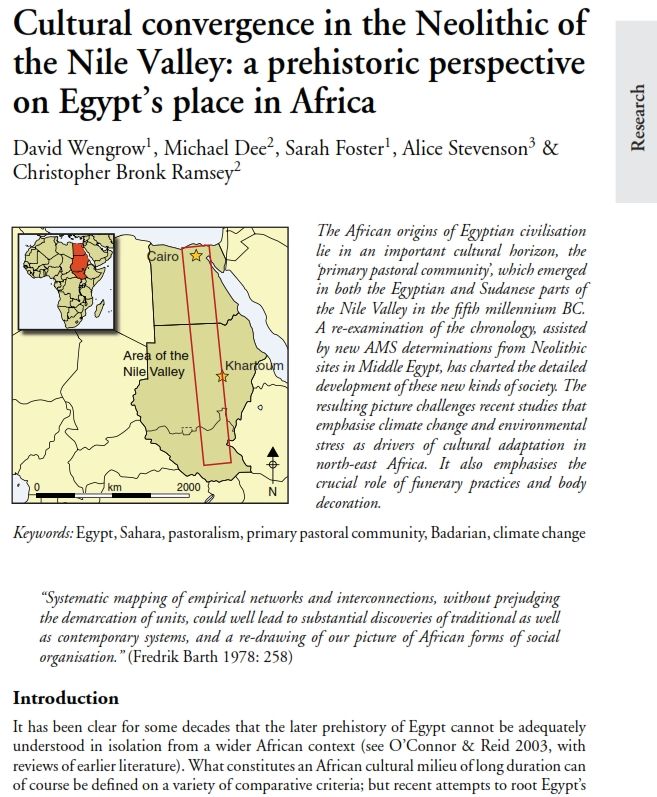Im Kemet Rocky & I like penis
googling gay porn :ahh:

Main aspects (citation in bold):
- The African origins of Egyptian civilisation lie in an important cultural horizon, the ‘primary pastoral community’, which emerged in both the Egyptian and Sudanese parts of the Nile Valley in the fifth millennium BC.
- The aim of the present article is to define an important horizon of cultural change, belonging to the fifth millennium BC, linking Egypt’s early development firmly to that of its southern neighbours in Nubia and central Sudan.
- This cultural horizon is situated between the green Sahara (early-mid holocene) period (Wavy Line pottery culture) and Badarian/Naqada period. All in the 5th Millennium BC. The Sahara was in the process of desertification. Most population were still mobile but maintained a certain cultural uniformity across the Nile and surrounding desert areas (Nabta Playa, Gebel Ramlah, Kharthoum, etc).
- ...the characteristic features of the ‘primary pastoral community’ may appear slightly earlier in the Sudanese than in the Egyptian part of the valley, suggesting a possible spread from south to north during the course of the fifth millennium.
- Neolithic of the Nile Valley constitutes a cultural phenomenon of impressive coherence, scale and duration.
- It is during this period [edit:5th Millennium BC] that burial grounds of varying size—but rarely exceeding a hundred individuals within a single cemetery—become a widely visible feature in the archaeological record of this region.
- ...the sites have a broadly similar character along both its Egyptian and Sudanese courses
- These developments are echoed in the changing location of herding and fishing camps along the margins of the floodplain. Seasonally occupied sites of this kind constitute our main evidence for the nature of human habitation along the Nile Valley during the fifth millennium BC. Comprising loose configurations of post-holes, dung deposits, hearths and thin ash-middens, the sites have a broadly similar character along both its Egyptian and Sudanese courses (e.g. Welsby 2000; Hendrickx et al. 2001; Honegger 2001; Sadig 2010) and are best understood as the remains of seasonal encampments, reflecting high levels of residential mobility among herder-fisher-forager populations (cf. Butzer 1976: 14; Trigger 1983: 28; Caneva 1991; Midant-Reynes 2000: 160)
- Indicators of sustained investment in cereal farming and sedentary life—such as durable architecture, heavy plant processing equipment, and high proportions of cereal grains in botanical samples—make their first appearance in the Egyptian Nile Valley only later, in the early fourth millennium BC (Midant-Reynes & Buchez 2002: 485–99; Wengrow 2006: 33, 76–82, with further
references).
- The overall patterning of the archaeological record in Middle-Upper Egypt suggests, instead, that low-level cereal farming on the floodplain was practiced within the context of a seasonal herding, fishing and foraging economy.
- Recent discoveries at the Neolithic cemetery of el-Barga, in the Kerma region of northern Sudan, raise the further possibility that this ritual-territorial system, and its sophisticated modes of body decoration, extend back in time beyond the fifth millennium BC
- Shared features of Neolithic burial across the Nile Valley (aka aspect of cultural uniformity):
> Treatment and ornamentation of the corpse (see text and below)
> Deposition of functionally similar artefacts within graves (see text and below)
- Throughout the Nile Valley, and into the neighbouring deserts, treatments of the body in death became remarkably uniform in this period
it basically shows the pottery style that has lasted for 3000 years thats spread from the nile valley, it also show the indigenous similarities between the eastern African cultures and east/northern African cultures and populations.
sources and thanks: http://www.egyptsearch.com/forums/ultimatebb.cgi?ubb=get_topic;f=8;t=008903
http://www.academia.edu/6346508/_co...ve_on_Egypts_place_in_Africa._Antiquity_2014_

